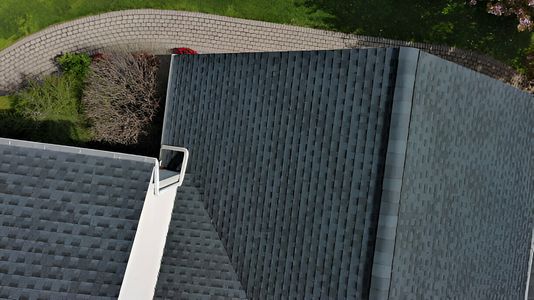Roofing Permits and Building Codes: What You Must Know
 Straight Path Construction
24 May, 2025
8 mins read
29
Straight Path Construction
24 May, 2025
8 mins read
29

Before replacing or modifying a roof, many municipalities require permits to ensure compliance with local building codes.
Why Permits Matter:
- Ensures structural safety and weather resistance
- Required for insurance coverage and home resale
- Protects you from fines or forced rework
What Typically Requires a Permit:
- Full roof replacement (not repairs)
- Structural changes (adding dormers, skylights)
- New rooflines or additions
Pro Tip: A reputable contractor will pull the permits for you—but always confirm before the job starts.
🢠Commercial Roofing 101: A Guide for Business Owners
Commercial roofing differs from residential in scale, material, and maintenance.
Common Commercial Roof Types:
- TPO & PVC: Energy efficient, great for flat roofs
- EPDM: Budget-friendly and durable
- Metal Roof Panels: Excellent lifespan and storm resistance
- Built-Up Roofing (BUR): Layered tar and gravel—long used on warehouses and factories
Commercial Considerations:
- Flat or low-slope designs need custom drainage plans
- Access and safety measures are more regulated
- Regular maintenance contracts are crucial
Fact: Many commercial roofs are “green-roof ready†and can incorporate solar or vegetation layers for tax and energy benefits.
🧮 Insurance and Roofing: What’s Covered and What’s Not
Understanding how your roof interacts with your homeowner’s insurance is key.
Typically Covered:
- Hail, wind, or storm damage
- Fire
- Falling tree limbs
Not Covered Without Endorsements:
- Gradual wear and tear
- Improper installation
- Poor maintenance
- Damage from pre-existing issues
Pro Tip: After a storm, file a claim immediately—insurers may deny delays.
🧑â€ðŸ« Educating Yourself: Roofing Resources for Homeowners
Want to go deeper? Here are top roofing education tools:
- GAF Roofing Learning Portal – Offers guides, videos, and certification info
- CertainTeed Roofing Guide – In-depth product details and maintenance tips
- National Roofing Contractors Association (NRCA) – Industry standards and homeowner resources
- YouTube Channels like Roof Hub, Roofing Insights, and This Old House – Visual demos of installations and repairs
Recommendation: Watch “how it’s installed†videos for your specific material before hiring a contractor—it helps you ask smarter questions.
💼 Choosing Between Roofing Bids: Apples-to-Apples Comparison
When collecting estimates, it’s not just about price—it’s about value.
Checklist for Comparing Roofing Bids:
- Same material type and grade
- Clear labor breakdown
- Inclusion of tear-off and disposal
- Type of underlayment and flashing
- Ventilation strategy
- Warranties for materials AND labor
Avoid the cheapest bid if it cuts corners on flashing, sealing, or cleanup—it’ll cost you later.
🧯 Emergency Roofing: What to Do When Disaster Strikes
Storm ripped off half your shingles? Don’t panic—act fast.
Steps to Take:
- Document damage with photos/video
- Apply a tarp if safe to do so—secure with 2x4s and nails
- Call your insurance provider
- Schedule an emergency repair (reputable roofers often offer storm services)
- Keep receipts for any temporary fixes
Safety Tip: Never go on the roof during or immediately after a storm. Prioritize safety, not speed.
🧑â€ðŸ”§ DIY Roofing Repairs: What You Can (and Can’t) Safely Do
Some small jobs are DIY-safe—but be realistic.
✅ Safe for DIY:
- Replacing a few loose or missing shingles
- Cleaning and unclogging gutters
- Installing gutter guards
- Applying roof sealant to small cracks
⌠Not Safe for DIY:
- Full shingle layers or tile replacement
- Flashing installation
- Structural decking repairs
- Any steep-pitch roof work
Essential Gear for Safe Roof Work:
- Harness and anchor system
- Soft-soled roofing boots
- Ladder stabilizer
- Non-slip pads and gloves
📊 Roof Replacement Timeline: What to Expect
Knowing what happens when makes the experience smoother.
Day-by-Day Breakdown:
Before the job:
- Permit pulled, materials delivered
- Protect landscaping and driveway with tarps or plywood
Day 1:
- Tear-off of old materials
- Decking inspection and repair (if needed)
Day 2–3:
- Underlayment, flashing, ventilation installed
- Shingles or panels installed
- Cleanup begins
Final Day:
- Walkthrough inspection
- Final cleanup with magnetic sweeper
- Warranty and maintenance instructions provided
ðŸ Wrap-Up: You’re Now a Roofing Expert (Almost)
From materials and maintenance to insurance and innovation, you’ve explored nearly every critical aspect of expert roofing in calgary. This knowledge gives you:
✅ Confidence in hiring
✅ Peace of mind in emergencies
✅ Insight for upgrades
✅ Power to protect your investment
📘 Next Steps:
Would you like this content turned into:
- A digital homeowner’s roofing handbook?
- An SEO-optimized blog series?
- A gated lead magnet for roofing contractors?
- Infographics and printable checklists?
Written By:
Straight Path Construction



Hotels at your convenience
Now choose your stay according to your preference. From finding a place for your dream destination or a mere weekend getaway to business accommodations or brief stay, we have got you covered. Explore hotels as per your mood.


